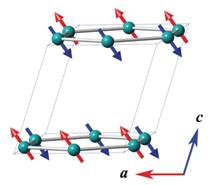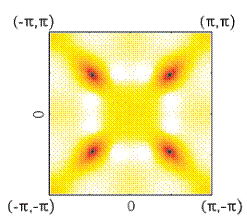Recently, Prof. Ji Feng’s research group of the International Center for
Quantum Materials (ICQM), School of Physics, Peking University, made a series of
progresses in computational and theoretical studies of novel quantum states in
oxides. These studies include the exploration of magnetic structure of
spin-liquid oxides, topological electronic states at the interface of simple
oxides, and tunable valley degeneracy splitting. They were recently reported by
Physical Review Letters, Nano Letters, and Physical Review B (Rapid
Communications), respectively.
As a 5d metal oxide, Na2IrO3 has attracted much attention in recent years,
owing to its potential in realizing the Kitaev model. The Kitaev model describes
a spin-1/2 system with a two-dimensional (2D) honeycomb lattice, whose ground
state is a spin liquid and can be used to realize topological quantum
computation. Therefore, there is a great deal of interest this kind of “Kitaev
matter”. Currently Na2IrO3 is the most extensively studied candidate in this
regard. Na2IrO3 has a layered structure, where Ir atoms form a two-dimensional
honeycomb lattice (Figure 1). Due to the crystal-field splitting and strong
spin-orbit coupling, the d-electrons of Ir atoms can be described by an
effective 1/2 pseudospin.
However, the experimental studies on the crystal and magnetic structures have
undergone several revisions. Kaige Hu, a postdoc in Prof. Feng’s group, carried
out first-principles calculations of the magnetic structure of Na2IrO3, and
found that the zigzag ordered magnetic moments are not aligned along the
crystallographic a axis established by previous experiments, and not even in the
Ir honeycomb lattice plane (i.e., the ab plane), but lie in the ac plane and
parallel to g=a+c. Such computational results are further explained by a
modified Kitaev-Heisenberg model, which is critical to the understanding of the
electronic structure of this compound and designing/realizing the Kitaev ground
state. This work is a result of a collaboration with Prof Fa Wang, and just
appeared in Physical Review Letters on Oct. 16, 2015: PRL 115, 167204 (2015),
and Dr. Kaige Hu is the lead author. Remarkably, the theoretical prediction of
this work has been confirmed by an independent and very recent experiment
(Nature Physics 11, 462 (2015)).

| 
|
Figure 1 Na2IrO3 has a layered structure, where Ir atoms form a 2D honeycomb
lattice and the zigzag-ordered magnetic moments are aligned along the g=a+c
direction.
| Figure 2 Calculated Berry curvature of the CrO2/TiO2 heterostructure, which
demonstrates that the interfacial material is a Chern insulator with a Chern
number of 2.
|
The Feng group is also active in designing new topological states on the
oxide interfaces. Quantum anomalous Hall (QAH) effect is a topological quantum
state with non-zero Chern number in the absence of external magnetic field. To
date the QAH effect was experimentally realized only by magnetic doping of the
surface state of topological insulator. Prof. Ji Feng’s research group and
collaborators proposed a novel theoretical strategy to realize QAH states
without the need for topological insulator and magnetic doping, which make
possible a Chern insulator proper. By interfacial orbital design and
first-principles calculations, they showed that the interface CrO2/TiO2 harbors
a 2-dimensional electronic phase, dubbed single-spin “graphene”. When the
spin-orbit coupling is taken into consideration, CrO2/TiO2 superlattice becomes
a Chern insulator, one that has perfect crystalline symmetry and requires no
doping. This work was published by Nano Letters on Aug. 25, 2015: Nano Letters
15, 6434 (2015). Xiao Li, a Ph. D graduate under supervision of Profs. Enge Wang
and Ji Feng and now a postdoctoral fellow in the University of Texas at Austin,
is one of the lead authors.
Oxides also play an important role in modifying the electronic properties of 2D
layered materials as substrates. 2D transition-metal dichalcogenide, with a pair
of degenerate valleys in the band structure, is a class of promising
valleytronic materials. Lifting the valley degeneracy of transition-metal
dichalcogenide in a controllable way is an attractive route to achieve various
optoelectronic manipulations. However, the magnetic field only creates a very
small valley splitting (~0.1 meV/T). Using first-principles calculations and
taking the MoTe2/EuO heterostructure as an example, Prof. Ji Feng’s research
group and its collaborators proposed that a giant valley splitting over 300 meV
can be generated by proximity-induced Zeeman effect. The valley splitting in the
heterostructure is also continuously tunable by rotating the substrate
magnetization. The giant and tunable valley splitting adds an extra dimension to
the exploration of unique optoelectronic devices based on magneto-optical
coupling and magnetoelectric coupling. This work was published by Physical
Review B (Rapid Communications), 2015: PRB 92, 121403(R) (2015). Dr. Xiao Li is
again one of the lead authors.
The above researches are supported by National Basic Research Program of
China, National Natural Science Foundation of China, Thousand Talents Program
for Young Scientists of China, and Collaborative Innovation Center of Quantum
Matter, China. Collaborators include Profs. Fa Wang and Qian Niu from Peking
University, Prof. Jingshan Qi from Jiangsu Normal University, and Profs. Sheng
Ju and Tianyi Cai from Soochow University.
